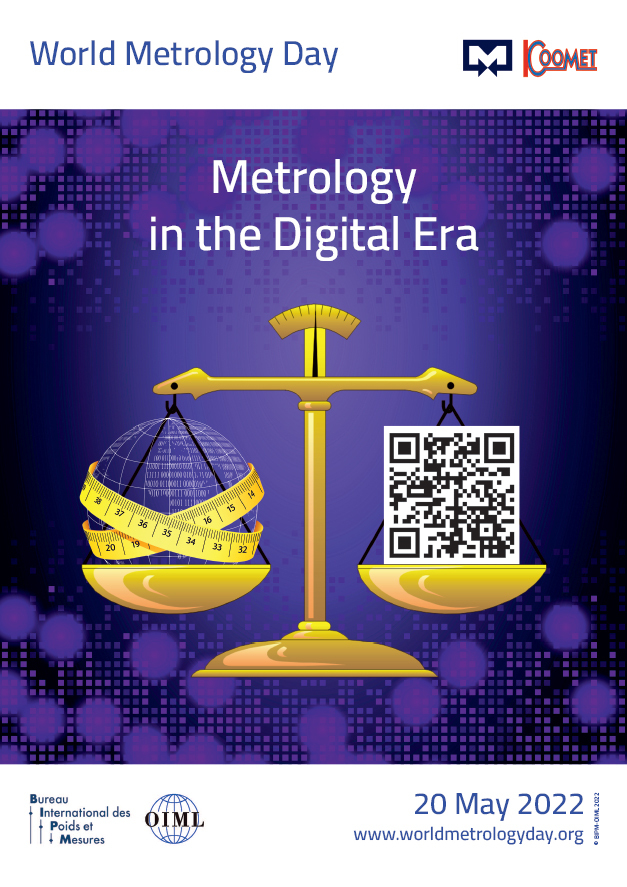联系方式
协会电话:0769-82633291
培训电话:0769-23060132
19928172638
协会邮箱:dgjlxh@163.com
培训邮箱:jiliangpeixun@163.com
微信公众号:东莞市计量协会
微信订阅号:东莞计量协会
协会微信小程序:东莞市计量协会
培训微信小程序:东莞计量技术培训
扫一扫
关注微信公众号
【行业资讯】2022年世界计量日主题:Metrology in the Digital Era
信息来源:东莞市计量协会 发布日期:2022-03-21
日前,2022世界计量日主题确定为“Metrology in the Digital Era”,今年的世界计量日海报由欧亚国家计量院合作联盟(COOMET)和乌克兰国家计量院合作设计。

国际计量局(BIPM)和国际法制计量局(BIML)局长寄语2022世界计量日
World Metrology Day: 20 May 2022
Metrology in the Digital Era
Metrology in the Digital Era
The adoption of digital technology is revolutionizing our community. It is improving processes and opening new opportunities. It is one of the most exciting trends in society today, typifying the rapid pace of change that we are experiencing every day.
One of the cornerstones of digital transformation is the open and transparent exchange of information. Whenever information is needed it must be easy to find and easy to access in a format that is both inter-operable and reusable. Data that meet these requirements are what are now known as being “FAIR”1. That is, they must be Findable, Accessible, Interoperable and Reusable. When these requirements are met, data can be recognized as being trustworthy and can underpin open data practices.
In order to maximize the efficiency with which information is used in the new digital world it is essential that all sources of information should not only be readable by humans but also be available in formats that can be read by machines. When this is the case, it might also be acted upon by machines (i.e. be “machine actionable”) and used as the basis for new applications of artificial intelligence.
The opportunities brought by digital transformation will be realized more quickly if the global quality infrastructure can be adapted to promote and use new digital technologies that generate and use data that is FAIR. Amongst the central components of the national and international quality infrastructure is metrology – the science of measurement and its application, which is already starting to support the requirements of the new digital economy.
A leading example of the actions to support the digital transformation is the work of the CIPM to develop an SI Digital Framework. This Framework will be based on a core representation of the SI including agreed formats for basic data elements including values, units and uncertainties based on the SI Brochure. It will enable the implementation of new services by the NMIs, the BIPM and related organizations that make best use of open data formats, software tools and services that build upon the SI core representation. Such services will enable data to be available for analysis, to improve the quality of data, and to improve data transparency. The outcome of the SI Digital Framework will be new digital applications developed and deployed in the broader metrology community and in research disciplines that rely on the SI.
The application of digital measurement frameworks to industry and consumers is integral to an inclusive and trusted digital transformation. The incorporation of digital principles and practices in documentary standards and technical regulations from the outset is an area that the OIML is examining. A digital certificate of conformity which adheres to the FAIR principles is part of this narrative. The digital transformation of metrology can bring many benefits to our community. For example, it can expedite time-to-market for measurement products and services and reduce delays associated with approval processes. In turn, this contributes to innovation, product agility, and sustainability.
For the BIPM and the OIML, the journey towards achieving the goal of digitalization will be twofold. We will transition our own activities and services, which will in turn provide the digital foundations for all users of measurement data. This is a journey that will be both progressive and fascinating, and one which we look forward to sharing with our stakeholders.







